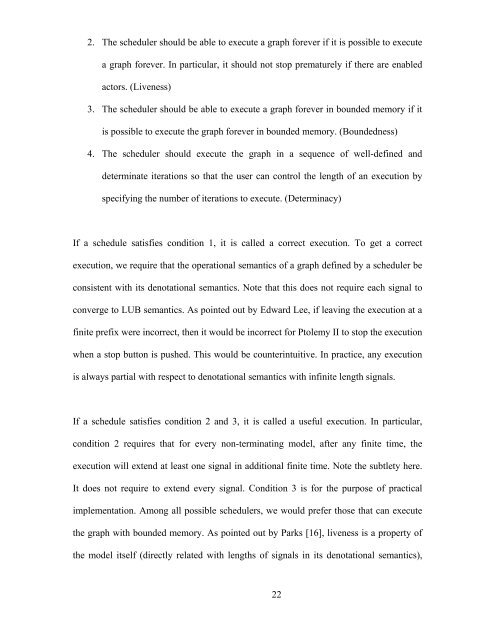Dynamic Dataflow Modeling in Ptolemy II - Ptolemy Project ...
Dynamic Dataflow Modeling in Ptolemy II - Ptolemy Project ...
Dynamic Dataflow Modeling in Ptolemy II - Ptolemy Project ...
Create successful ePaper yourself
Turn your PDF publications into a flip-book with our unique Google optimized e-Paper software.
2. The scheduler should be able to execute a graph forever if it is possible to execute<br />
a graph forever. In particular, it should not stop prematurely if there are enabled<br />
actors. (Liveness)<br />
3. The scheduler should be able to execute a graph forever <strong>in</strong> bounded memory if it<br />
is possible to execute the graph forever <strong>in</strong> bounded memory. (Boundedness)<br />
4. The scheduler should execute the graph <strong>in</strong> a sequence of well-def<strong>in</strong>ed and<br />
determ<strong>in</strong>ate iterations so that the user can control the length of an execution by<br />
specify<strong>in</strong>g the number of iterations to execute. (Determ<strong>in</strong>acy)<br />
If a schedule satisfies condition 1, it is called a correct execution. To get a correct<br />
execution, we require that the operational semantics of a graph def<strong>in</strong>ed by a scheduler be<br />
consistent with its denotational semantics. Note that this does not require each signal to<br />
converge to LUB semantics. As po<strong>in</strong>ted out by Edward Lee, if leav<strong>in</strong>g the execution at a<br />
f<strong>in</strong>ite prefix were <strong>in</strong>correct, then it would be <strong>in</strong>correct for <strong>Ptolemy</strong> <strong>II</strong> to stop the execution<br />
when a stop button is pushed. This would be counter<strong>in</strong>tuitive. In practice, any execution<br />
is always partial with respect to denotational semantics with <strong>in</strong>f<strong>in</strong>ite length signals.<br />
If a schedule satisfies condition 2 and 3, it is called a useful execution. In particular,<br />
condition 2 requires that for every non-term<strong>in</strong>at<strong>in</strong>g model, after any f<strong>in</strong>ite time, the<br />
execution will extend at least one signal <strong>in</strong> additional f<strong>in</strong>ite time. Note the subtlety here.<br />
It does not require to extend every signal. Condition 3 is for the purpose of practical<br />
implementation. Among all possible schedulers, we would prefer those that can execute<br />
the graph with bounded memory. As po<strong>in</strong>ted out by Parks [16], liveness is a property of<br />
the model itself (directly related with lengths of signals <strong>in</strong> its denotational semantics),<br />
22
















